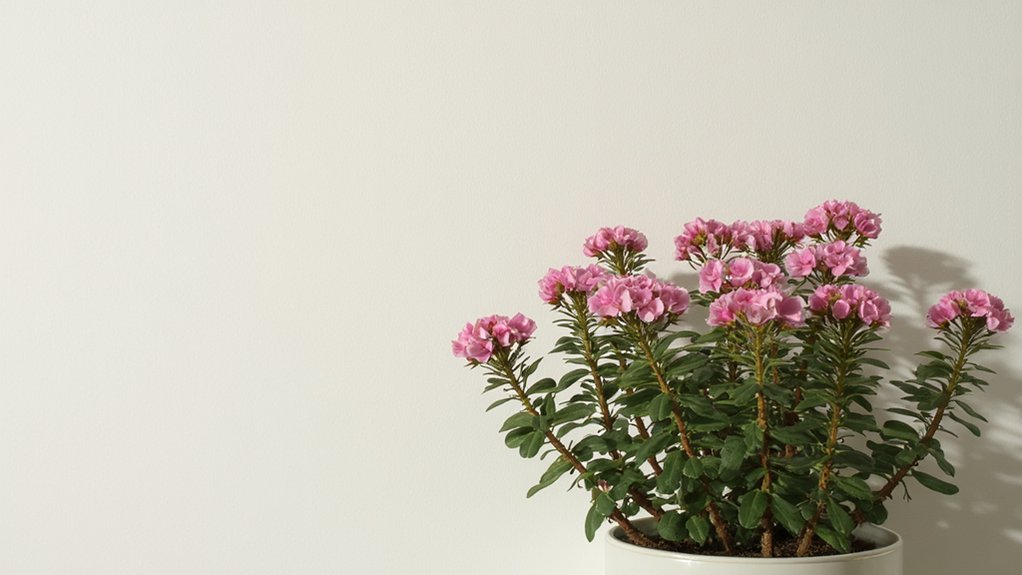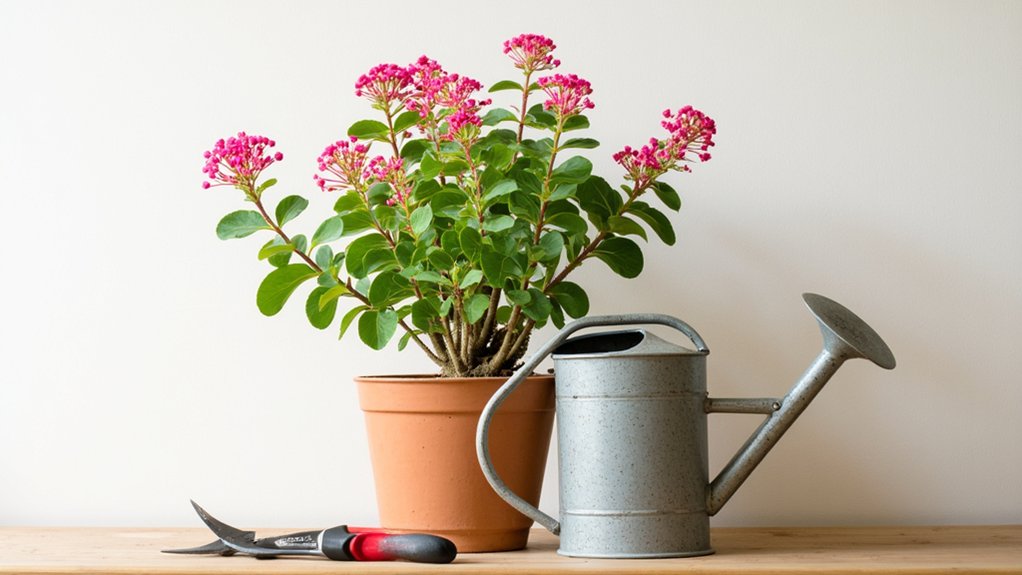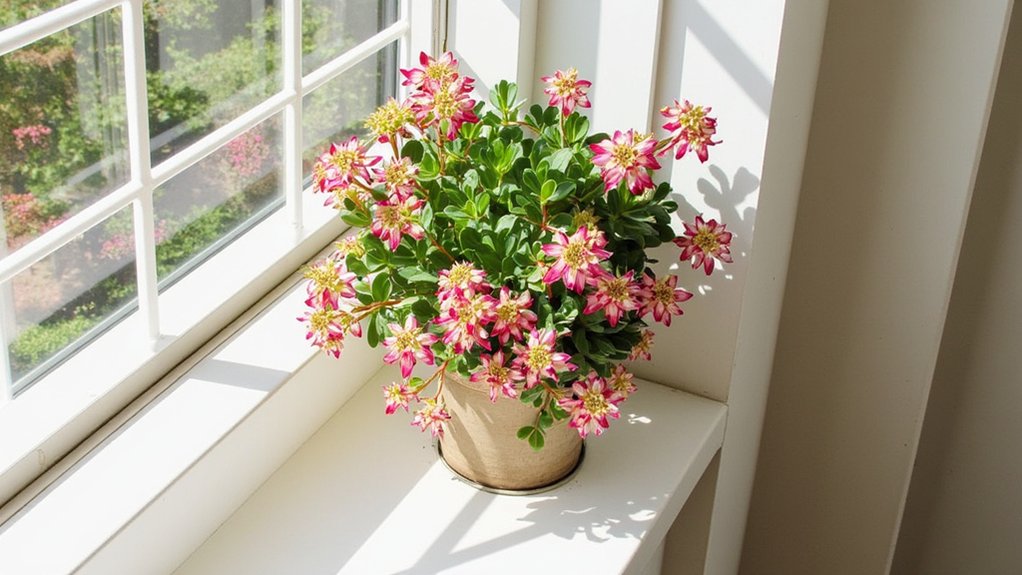Like a loyal companion guarding your well-being, the Kalanchoe plant offers an impressive array of benefits you won’t find in most houseplants. You’ll discover it’s not just a pretty succulent with vibrant blooms – it’s also a natural air purifier, stress reducer, and traditional healing aid that’s surprisingly easy to maintain. Whether you’re seeking better sleep, cleaner air, or natural remedies, this versatile plant’s capabilities might surprise you.
Contents
- 1 Air-Purifying Properties of Kalanchoe
- 2 Medicinal Uses in Traditional Healing
- 3 Easy Care and Maintenance Tips
- 4 Mental Health and Stress Relief Benefits
- 5 Decorative Appeal and Design Versatility
- 6 Natural Sleep Aid Properties
- 7 Anti-Inflammatory and Wound Healing Effects
- 8 Growing Kalanchoe for Better Indoor Air Quality
Air-Purifying Properties of Kalanchoe

While many houseplants can help clean indoor air, Kalanchoe stands out for its exceptional ability to filter harmful volatile organic compounds (VOCs). You’ll find it particularly effective at removing benzene and formaldehyde, common indoor pollutants that can off-gas from furniture and cleaning products.
To maximize your Kalanchoe’s air-purifying potential, you’ll want to place one plant per 100 square feet of space. It’s most effective during daylight hours when it’s actively photosynthesizing, and you’ll get the best results by positioning it near potential VOC sources, like new furniture or recently painted walls.
Medicinal Uses in Traditional Healing
Although modern medicine often overlooks traditional plant remedies, Kalanchoe has been used for centuries in folk healing practices across Africa, Asia, and South America.
You’ll find that healers commonly apply the plant’s crushed leaves directly to wounds, burns, and insect bites. The juice from Kalanchoe leaves contains compounds that can reduce inflammation and speed up healing time by up to 30%.
If you’re dealing with minor skin infections, you can create a simple poultice by crushing fresh leaves and applying them for 15-20 minutes. While scientific studies are still ongoing, traditional practitioners have successfully used Kalanchoe to treat respiratory issues, digestive problems, and even headaches.
Easy Care and Maintenance Tips

Three essential care tips make Kalanchoe one of the most beginner-friendly houseplants you’ll ever grow. You’ll need to place it in bright, indirect light and water only when the top inch of soil feels completely dry, typically every 2-3 weeks.
For ideal growth, maintain temperatures between 60-85°F, and don’t worry about humidity levels – these succulents aren’t fussy. When you’re repotting, which you’ll need to do every 18-24 months, choose a well-draining potting mix and a container just one size larger than the current pot.
Mental Health and Stress Relief Benefits
Beyond the physical care requirements, Kalanchoe plants offer remarkable mental health benefits for their owners. You’ll find that tending to these succulents can reduce your stress levels by up to 40% during a 15-minute care session, according to horticultural therapy studies.
When you place a Kalanchoe in your workspace, it’ll help improve your concentration and reduce mental fatigue. The plant’s rhythmic growth patterns and vibrant blooms stimulate your brain’s pleasure centers, while its oxygen-producing capabilities can enhance your mood and cognitive function.
The simple act of observing your Kalanchoe’s progress can provide a mindful escape from daily pressures, serving as a natural anxiety reducer.
Decorative Appeal and Design Versatility

While many houseplants offer basic visual appeal, Kalanchoe’s design versatility stands out with its compact size and stunning color variations. You’ll find blooms in vibrant reds, pinks, oranges, yellows, and whites, making it perfect for color-coordinated spaces.
At 8-12 inches in height, these succulents fit perfectly on windowsills, desks, or as table centerpieces. You can arrange them in clusters, pair them with other plants, or display them individually in decorative pots. Their naturally rounded shape and thick, scalloped leaves create visual interest even when they’re not flowering.
Add them to vertical gardens or hanging baskets for unexpected design elements.
Natural Sleep Aid Properties
Research has shown that Kalanchoe’s natural compounds can help improve sleep quality when placed in your bedroom. The plant releases oxygen throughout the night while filtering harmful indoor air pollutants that can disrupt your sleep patterns.
You’ll get the best results by placing one or two medium-sized Kalanchoe plants (6-8 inches tall) about 3-4 feet from your bed. The plant’s gentle presence works best when you’re exposed to it for 7-8 hours during your regular sleep cycle.
Don’t worry if you’re a restless sleeper – Kalanchoe’s sleep-promoting benefits work even if you toss and turn, as long as you keep it properly watered and healthy.
Anti-Inflammatory and Wound Healing Effects
The healing properties of Kalanchoe extend far beyond its calming nighttime effects. You’ll find these succulent plants contain powerful anti-inflammatory compounds that can help reduce swelling and discomfort when applied topically to affected areas.
For minor cuts and scrapes, you can apply crushed Kalanchoe leaves directly to the wound, replacing the dressing every 12 hours. The plant’s natural compounds stimulate collagen production and increase blood flow to the injury site.
Research shows that Kalanchoe’s juice contains specific flavonoids that inhibit inflammatory responses, making it particularly useful for treating burns, bruises, and skin irritations. You’ll want to test a small area first to confirm you don’t have any sensitivities.
Growing Kalanchoe for Better Indoor Air Quality
Because Kalanchoe plants naturally filter harmful indoor pollutants, you’ll benefit from placing several throughout your living spaces. These resilient succulents can remove common toxins like benzene and formaldehyde, which often lurk in household items and building materials.
For ideal air purification, you’ll want to position one 6-inch Kalanchoe plant per 100 square feet of space. Place them near potential pollution sources, such as new furniture, fresh paint, or cleaning supply storage areas. Keep the plants at least 6-8 inches away from walls to maximize air circulation.
Maintain your Kalanchoe in bright, indirect light and water every 2-3 weeks for best air-filtering performance.
